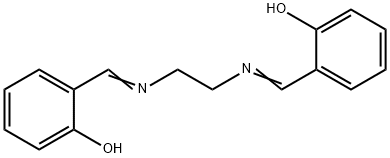N,N'-BIS(SALICYLIDENE)ETHYLENEDIAMINE
Synonym(s):N,N′-Ethylenebis(salicylimine);2,2′-Ethylenebis(nitrilomethylidene)diphenol
- CAS NO.:94-93-9
- Empirical Formula: C16H16N2O2
- Molecular Weight: 268.31
- MDL number: MFCD00002244
- EINECS: 202-376-3
- SAFETY DATA SHEET (SDS)
- Update Date: 2025-07-24 18:13:54

What is N,N'-BIS(SALICYLIDENE)ETHYLENEDIAMINE?
Chemical properties
YELLOW FINE CRYSTALLINE POWDER
The Uses of N,N'-BIS(SALICYLIDENE)ETHYLENEDIAMINE
In histochemistry to detect antigens.
The Uses of N,N'-BIS(SALICYLIDENE)ETHYLENEDIAMINE
N,N′-Bis(salicylidene)ethylenediamine (salen) immobilized on surfactant-coated alumina has been used as complexing agent for on-line preconcentration of copper and lead by flow injection-flame atomic absorption spectrometry (FI-AAS).
What are the applications of Application
N,N′-Bis(salicylidene)ethylenediamine is a fluorescent indicator
Definition
A green fluorescent compound.
General Description
N,N′-Bis(salicylidene)ethylenediamine (salen) reacts with ferric chloride in acetone solution to yield the complex (Fe salen Cl).
Properties of N,N'-BIS(SALICYLIDENE)ETHYLENEDIAMINE
| Melting point: | 127-128 °C(lit.) |
| Boiling point: | 411.48°C (rough estimate) |
| Density | 1.1028 (rough estimate) |
| refractive index | 1.6240 (estimate) |
| storage temp. | Sealed in dry,Room Temperature |
| solubility | chloroform: 0.1 g/mL, clear |
| pka | 12.59±0.50(Predicted) |
| form | crystal |
| color | yellow |
| Merck | 14,8322 |
| BRN | 535296 |
| CAS DataBase Reference | 94-93-9(CAS DataBase Reference) |
| EPA Substance Registry System | Phenol, 2,2'-[1,2-ethanediylbis(nitrilomethylidyne)]bis- (94-93-9) |
Safety information for N,N'-BIS(SALICYLIDENE)ETHYLENEDIAMINE
| Signal word | Warning |
| Pictogram(s) |
 Exclamation Mark Irritant GHS07 |
| GHS Hazard Statements |
H315:Skin corrosion/irritation H319:Serious eye damage/eye irritation H335:Specific target organ toxicity, single exposure;Respiratory tract irritation |
| Precautionary Statement Codes |
P261:Avoid breathing dust/fume/gas/mist/vapours/spray. P264:Wash hands thoroughly after handling. P264:Wash skin thouroughly after handling. P271:Use only outdoors or in a well-ventilated area. P280:Wear protective gloves/protective clothing/eye protection/face protection. P302+P352:IF ON SKIN: wash with plenty of soap and water. P305+P351+P338:IF IN EYES: Rinse cautiously with water for several minutes. Remove contact lenses, if present and easy to do. Continuerinsing. |
Computed Descriptors for N,N'-BIS(SALICYLIDENE)ETHYLENEDIAMINE
| InChIKey | VEUMANXWQDHAJV-JYFOCSDGSA-N |
New Products
Indole Methyl Resin tert-butyl 9-methoxy-3-azaspiro[5.5]undecane-3-carboxylate Boc-His(Boc)-OH 2-CTC Resin 4-Chloro-7-tosy1-7Hpyrrolo[2,3-d]pyrimidine 5,7-Dibromo-1H-indole 2,5-dichloro-N-hydroxy-4,6-dimethylpyridine-3-carboximidamide 2,2-Dimethoxy-7-azaspiro[3.5]nonane hydrochloride 4-chloromethyl-5-methyl-1,3-dioxol-2-one (DMDO-Cl) R-2-BENZYLOXY PROPIONIC ACID 1,1’-CARBONYLDIIMIDAZOLE 1,1’-CARBONYLDI (1,2-4 TRIAZOLE) N-METHYL INDAZOLE-3-CARBOXYLIC ACID 4-((2-hydroxyethyl)thio)benzoic acid 1-(TERT-BUTOXYCARBONYL)-2-PYRROLIDINONE Methyl 6-methylnicotinate 3-Pyridineacrylic acid tert-Butyl carbazate TETRAHYDRO-2H-PYRAN-3-OL 2-((4-morpholinophenylamino) (methylthio) methylene) malononitrile 3-(4-morpholinophenylamino)-5-amino-1H-pyrazole-4-carbonitrile 2,4-dihydroxybenzaldehyde 1,3-Diethyl-1,3-Diphenylurea Methyl 2-methylquinoline-6-carboxylateRelated products of tetrahydrofuran







![2,4-DITERT-BUTYL-6-((E)-[(2-([(E)-(3,5-DITERT-BUTYL-2-HYDROXYPHENYL)METHYLIDENE]AMINO)CYCLOHEXYL)IMINO]METHYL)PHENOL](https://img.chemicalbook.in/StructureFile/ChemBookStructure4/GIF/CB5776278.gif)
You may like
-
 N,N'-Bis(salicylidene)ethylenediamine CAS 94-93-9View Details
N,N'-Bis(salicylidene)ethylenediamine CAS 94-93-9View Details
94-93-9 -
 N,N'-Bis(salicylidene)ethylenediamine 95% CAS 94-93-9View Details
N,N'-Bis(salicylidene)ethylenediamine 95% CAS 94-93-9View Details
94-93-9 -
 N,N′-Bis(salicylidene)ethylenediamine CAS 94-93-9View Details
N,N′-Bis(salicylidene)ethylenediamine CAS 94-93-9View Details
94-93-9 -
 Pyridine 99.5% HPLC /UV SpectroscopyView Details
Pyridine 99.5% HPLC /UV SpectroscopyView Details
110-86-1 -
 Piperazine Spot supply, best priceView Details
Piperazine Spot supply, best priceView Details
110-85-0 -
 Dibutyl PhthalateView Details
Dibutyl PhthalateView Details
84-74-2 -
 Imidazole Spot supply, competitive priceView Details
Imidazole Spot supply, competitive priceView Details
288-32-4 -
 Thiourea 99% ARView Details
Thiourea 99% ARView Details
62-56-6
Statement: All products displayed on this website are only used for non medical purposes such as industrial applications or scientific research, and cannot be used for clinical diagnosis or treatment of humans or animals. They are not medicinal or edible.
